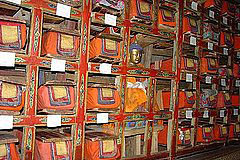 |
The Five Great Treatises form the basis of all Buddhist philosophical studies. Here is an overview and short explanation of the texts, as taught in the Gelug Monasteries. These are commentaries written by various scholars over centuries to clarify points in the teachings of the Buddha. They constitute the backbone of the geshe studies. Many other texts and commentaries are studied to complement the teachings on a progressively deeper level.
The studies of these texts take between 16 - 25 years, depending on the level of knowledge aspired to.
Prajnaparamita: A text composed by Lord Maitreya clarifying the methodology of the Mahayana tradition as laid out in the Prajnaparamita literature.
Madhyamikavatara: a treatise composed by Chandrakirti* that clarifies the thought of Nagarjuna*, one of the great Nalanda masters. This text establishes the Prasangika view of emptiness. This text was recommended to Lama Tsong Khapa* by his guru, Manjushri*.
Pramanavartika (Valid Cognition): A treatise by Dharmakirti*, commenting on the classic Pramana by his predecessor Dignagam* that provides the principle Mahayana Buddhist position on epistemology and logic in the context of explaining the path to liberation.
Abhidharmakosha: a treatise by Vasubhandu* that explains the phenomenological basis of things and events (metaphysics) external and internal, as understood by the Sautantrika school of Buddhist philosophy.
Vinaya: A treatise by Gunaprabha* that clarifies the mulasarvastivadin interpretation of the Buddha's teachings on discipline especially in the context of the rules for the monastic community.
In acommentary by Tenpa Dolme Kundang, the five treatises are described as the parts of a well functioning body:
- · The Prajnaparamita text constitutes the whole person.
- · This person needs wisdom, which is also called the correct view. This is explained in the Madyamika texts.
- · For the correct view to function properly, scientific reasoning or logic is needed. This is provided by the Pramanavartika texts.
- · The person needs also to have a moral framework to be helpful to otherS, which is provided in the Vinaya, the set of rules on conduct.
- · And lastly the Abhidharmakosha contains everything. Its chapters describe the person according to its functions, organs and composition.
Length of study needed to complete the five text
The minimum time for the study of these five texts at Kopan is 16 years, after which Kopan Monastery bestows the Rabjam geshe degree. In the three great monasteries of the Gelug tradition (Sera, Ganden and Drepung), the geshe degrees are slightly different, with more advanced degrees possible. The highest geshe degree is a Lharampa Geshe, a post graduate degree which involves more than twenty five years of study.
The asterix * indicates the names of great philosophers from the Nalanda School (12th – 14th century) of Buddhist teachings.

